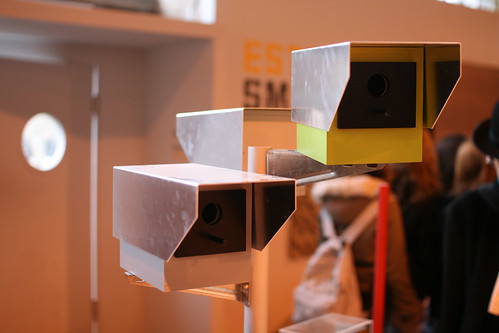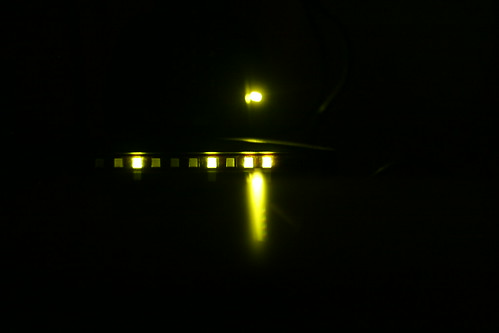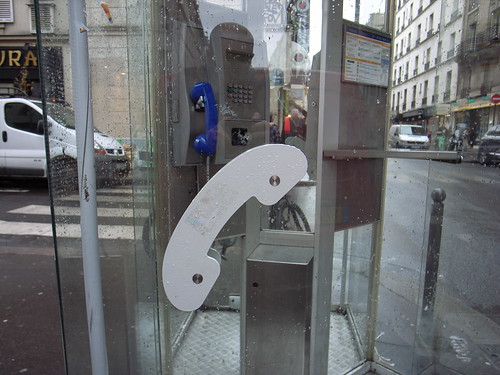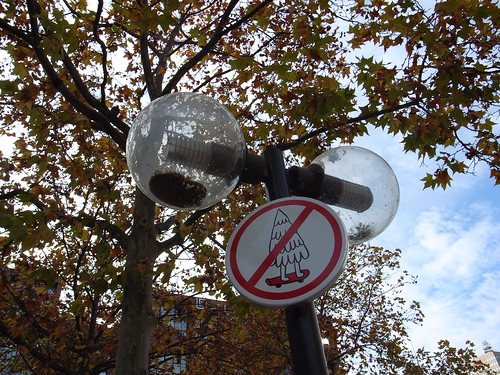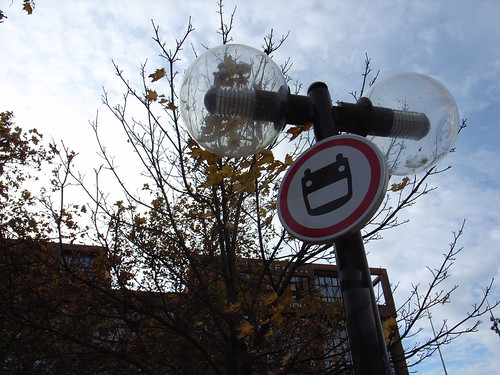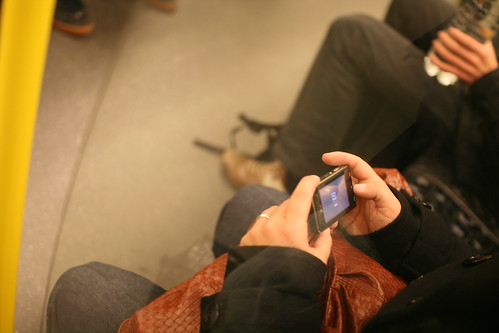Talk in Paris tomorrow about pervasive art
Will be in Paris tomorrow at École Nationale Supérieure des Arts Décoratifs (ENSAD) to give a talk as part of conference called Mobilisable. I'll be in the "pervasive art" session around 7pm along with Samuel Bianchini, Lalya Gaye and Usman Haque. Mobilisable is a conference about research and artistique creation with mobile and locative media. It is “a project of the research program « Forms of Mobility ». It is directed by the École nationale supérieure des arts décoratifs and the Université Paris 8 in cooperation with the École nationale supérieure d’architecture de Toulouse, the Haute école d’art et de design-Genève and the Tokyo University of the Arts.
The whole thing is free but certainly in french. Here's the description of the session:
"Environment, performance, « in situ », body art, … far from restricting itself to the object, contemporary art has long since conquered all sorts of spaces and situations. As mobile, diffuse and interconnected devices are increasingly operated, this development is still growing. Contemporary art seems to merge with the new informational ubiquitous paradigms of the « everyware ». The communicating objects are leaving their object status behind, as they reduce in size and invade more and more diffuse situations in our environment, by grafting onto ordinary objects that can also be worn (« wearable technology ») or even by being implanted in our bodies. If the first ones mentioned are not necessarily mobile, the second ones are, since they accompany us in each and every movement. And all of these are able to communicate and to create networks ad hoc, which are continually reconfigured. In this way, our public, professional and private spheres will soon be invaded. Which artistic form can be given to these devices and to their applications ? Between « ambient intelligence » and society of access and/or of control, how can the artist take a position regarding these new forms of hybrid networks ? How can he put in place, infiltrate or even exfiltrate these mobile and diffuse technologies ?"
Will talk about why, as a researcher in the ubicomp area, I am interested in what artists are doing, and how it helps the field to move forward.
blended ecologies pics
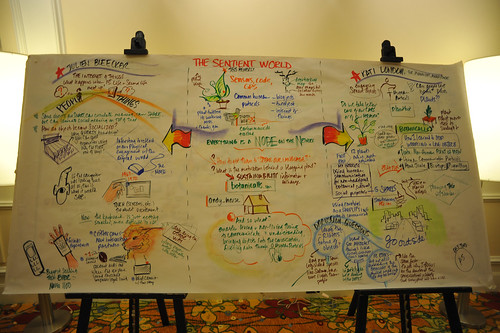 People interested in hybridized ecologies (how the digital and the physical can be interlinked) and how they can be designed in weird ways may be interested to have a look at Julian's pictures from a workshop carried out at the Institute For The Future in Palo Alto last week.
People interested in hybridized ecologies (how the digital and the physical can be interlinked) and how they can be designed in weird ways may be interested to have a look at Julian's pictures from a workshop carried out at the Institute For The Future in Palo Alto last week.
There is also a report about this topic but it's not accessible to the public.
Night light night life
 What stays awake during the night, what should not stay awoken when not used.
What stays awake during the night, what should not stay awoken when not used.
Approximately 15% of people's electricity bills can be saved if these lights were switched off.
Inspired by recent discussions with students at ENSCI, who works on a project about how the internet of things can be an inspiring framework to rethink our relationship to energy consumption.
Design research topography
 The first issue of Design Research Quarterly features the above map that represents the "topography of design research" (made by Liz Sanders).
The first issue of Design Research Quarterly features the above map that represents the "topography of design research" (made by Liz Sanders).
She basically mapped the different approaches to design research based on two dimensions:
- Their impetus: tools and methods coming from design practice versus those coming from the research perspective. To date, as she points out, most of the methods seem to be coming from the research field.
- The mindset of those who practice and teach design research: the expert versus the participatory mindset. Which actually corresponds to the level of engagement designers have with people (informants, users, etc.)
The visualization of the different methods and approaches allows to represent different clusters of activity (human factors/ergonomics, applied ethnography, usability testing). You can also read an update of this article in the last issue of ACM interactions.
Why do I blog this? an interesting mapping to be used in my course about UX research. Coming from the user-centered design cluster (ergonomics mostly but now doing applied ethnography), it took me a lot of time to get the global picture represented on this representation. It also took me some time to understand the underlying issues and struggles between the different perspectives as most of them are grounded in different vision of what humans beings are and why they do what they do.
What shows up and what doesn't show up
Reading this article in The Economist about some problems encountered by scientific research, I stumble across this intriguing paragraph:
"There also seems to be a bias towards publishing positive results. For instance, a study earlier this year found that among the studies submitted to America’s Food and Drug Administration about the effectiveness of antidepressants, almost all of those with positive results were published, whereas very few of those with negative results were. But negative results are potentially just as informative as positive results, if not as exciting."
Why do I blog this? That's surely a problem I encountered when writing during my PhD work. It's funny to notice this bias, especially when you know the value of negative results. It's clearly true that there is a tendency to prefer selling "positive" experimental results than negative ones... which are in general less described.
Being interested in UX research, I also draw a parallel between this example and the sort of things we are looking for in user research: most of the work is about usage (what people do with/without technology), but it's also important to consider what people don't do. There are surely some relevant questions to ask concerning what shows up and what doesn't show up in field research.
Phone affordance
William Gibson on scifi
New Scientist has a quick piece by William Gibson that is somewhat intriguing if you're interested in building near futures. A sort of extension of "the future is just here, it's not evenly distributed". See for example:
"The single most useful thing I've learned from science fiction is that every present moment, always, is someone else's past and someone else's future. I got that as a child in the 1950s, reading science fiction written in the 1940s; reading it before I actually knew much of anything about the history of the 1940s or, really, about history at all. I literally had to infer the fact of the second world war, reverse-engineering my first personal iteration of 20th-century history out of 1940s science fiction. I grew up in a monoculture - one I found highly problematic - and science fiction afforded me a degree of lifesaving cultural perspective I'd never have had otherwise. I hope it's still doing that, for people who need it that way, but these days lots of other things are doing that as well. (...) I took it for granted that the present moment is always infinitely stranger and more complex than any "future" I could imagine. My craft would be (for a while, anyway) one of importing steamingly weird fragments of the ever-alien present into "worlds" (as we say in science fiction) that purported to be "the future"."
Why do I blog this? very interesting elements here to link with what Charles Stross discussed recently concerning near future SF. Also important when you think how scifi is about the past and the present (or at least as a discourse about these different timeframes and what is important before and during the time the author wrote).
The relation to design? Simply, the Uncanny of the present is material for design.
Portable gaming habits
Some insights from a recent study by NPD about portable gaming (collected from over 3,200 pre-identified sample owners of portable devices from September 16-23):
"79 percent [of those polled say] they use their portable device in-home, far more than any other location. (...) Gameplay is the feature used by most (84 percent) on the PlayStation Portable. Slightly more than one third of PSP owners are watching movies (35 percent) and listening to music (33 percent) on their device (...) Ninety two percent of Nintendo DS owners are playing games by themselves followed by close to one quarter playing games with friends locally using one game cartridge. (...) Listening to music dominates iPod usage (96 percent) followed by playing games (20 percent) at a distant second."
Although it's not mentioned in the article, I guess it's a US study. The conclusion states that (1) these devices may be competing with more stationary entertainment devices for a user’s time, (2) the scope of gaming devices is changing to entertainment devices, (3) "iPods/iPhones are being treated as entertainment devices. Why do I blog this? interesting evolution in the last few months wrt mobile entertainment. I also wonder about the range of applications, especially on the Nintendo DS as there are more and more cartridges which are not really games (such as Hello Kitty diary for example). The possibility to design non-games is more and more intriguing in this field.
Future of economic and cultural exchange
 Recently been working on the future of economic and cultural exchange with a good bunch of people. The project is called KashKlash and has the following purposes:
Recently been working on the future of economic and cultural exchange with a good bunch of people. The project is called KashKlash and has the following purposes:
"KashKlash is a lively platform where you can debate future scenarios for economic and cultural exchange. Beyond today’s financial turmoil, what new systems might appear? Global/local, tangible/intangible, digital/physical? On the KashKlash site, you can explore potential worlds where traditional financial transactions have disappeared, blended, or mutated into unexpected forms. Understand the near future, and help shape it!
Imagine yourself deprived of all of today’s conventional financial resources. Maybe you’re a refugee or stateless — or maybe it’s the systems themselves that have gone astray. Yet you still have your laptop, the Internet, and a broadband mobile connection. What would you do to create a new informal economy that would help you get by? What would you live on? E-barter? Rationing? Gadgets? Google juice? Cellphone minutes? Imagine a whole world approaching that condition. Which of today’s major power-players would win and lose, thrive or fail? What strange new roles would tomorrow’s technology fill?""
This public domain project is conceived and led by Heather Moore of Vodafone’s Global User Experience Team and run by Experientia, an international forward-looking user experience design company based in Turin, Italy.
You can check the project description for more info.
KashKlash also involved a participatory exploration phase in which you can join and follow the debate of our experts or contribute yourself by leaving a comment on the different matters or fill out our KashKlash questionnaire.
Design and the Uncanny
 (Spare parts from an old robot encountered last year)
(Spare parts from an old robot encountered last year)
In "The Uncanny and The Everyday in the Design of Robots" (a paper submitted as a CHI workshop in 2004), Carl DiSalvo discusses an intriguing topic: how the design should not prevent people loosing sight how unusual certain artifacts are. He applies his reasoning to electronic products such as robots:
"Recently there has been a surge in the development of robots as products for use in offices, public spaces, and the home. (...) The forms and functions of robots are often explicitly constructed as imitations of living beings. Through these imitations, robots exhibit and are attributed qualities such as emotion, intelligence, and autonomy, (...) how can we avoid losing sight of how unusual it is to grant such qualities and roles to them? "
Di Salvo then proposes that "The Uncanny" is a relevant and critical approach to reveal the underlying issues and implications of robots. What he means by this term is simply that the familiar can act strangely, which is of course related to this "Uncanny Valley" notion:
"The Uncanny Valley is that point where the resemblance between a robot and a human is almost, but not quite, identical, and the tension between this difference/sameness is disturbing. Even though The Uncanny Valley has never been systematically examined, it is perpetuated in the robotics community as a place to be avoided. But perhaps, it is not a place to be avoided. Because The Uncanny causes us to confront basic assumptions central to the design of robots, perhaps it is exactly the place where a critical approach to the design of robots should focus. "
He then gives three conceptual propositions for the design of uncanny domestic robots:
- Robotic Vacuums That Speak Their Mind ("I have never been in this room before, please stay with me while I clean it.")
- Homely Homes For Robots, Unhomely Homes for Humans ("uncanny homes, homes that were unhomley for humans but homely for robots — redefining the artifact as an inhabit")
- Real Appliance Pets ("transform a robotic vacuum cleaner into a more realistic imitation of a pet")
Why do I blog this Beyond the fascination towards this sort of device (of course I'd love to have a nevrotic robot), I find this discussion about the Uncanny highly important. Not only about robots of course. Design is often based on the assumption that it will create objects and experiences that match up with people and their practices. Or that it can "integrate the new into the everyday". I wonder about different ways to go beyond this situation and what Di Salvo describes in this paper is surely an interesting solution to create enriching user experiences. I guess personalization is also another relevant possibility.
Location-based war game
It's been a while that I haven't seen lot of innovation in the field of location-based games. It's as if the game play were always repeated (object collection, finding a human who have to escape...). There were some good projects about this in the past but the field has some trouble going beyond a limited range of scenario.

Within this context, Turf Bombing, designed by Che-Wei Wang, looks intriguing:
"Turf Bombing is a location-based turf battle game which rewards and encourages traveling and learning about different neighborhoods.
This game requires a laptop and works anywhere in the world where there's a wifi connection. Your laptop's wifi connection is used to triangulate your position.
Gangs are assigned by the zip code of your home address. The goal of each gang is to gain as much territory as possible.
Territories are acquired as players plant time bombs at different locations in physical space. If the bomb is not diffused by a local gang member in time, the bomb will explode and the territory will be turned over to the gang that planted the bomb."
Why do I blog this? I find interesting the use of a location-based game as a way to encourage new transport modes. A sort of "serious game" in the field of pervasive gaming.
LBS troubles
Some material about location-based services... and how the user adoption of such artifact has been somewhat delayed (a topic I addressed copiously in my ETech 2008 presentation): First, this IHT article entitled "Still searching for profit in location-based services". It addresses how mobile operators are hoping that LBS can lead to new profit for quite a while now. The main issue is that while car navigation devices has been successfully adopted, other technologies typically remains "crude and unhelpful - and unused - for mobile navigation":
"Despite the increasing availability of GPS-enabled mobiles, many consumers are still reluctant to pay for mobile navigation, said Velipekka Kuoppala, a vice president for sales and marketing at Bluesky Positioning (...) How soon will the sales come? André Malm, a senior analyst at Berg Insight, offers this forecast: Global sales from location-based services will more than triple to $740 million annually by 2014, as the number of GPS users rises to 70 million globally from 16 million this year.
But for that to happen, Malm acknowledges, operators will have to sell mobile navigation services for which consumers are willing to pay."
David H. Williams at Directions Mag has its own bits about why LBS fails to reach a mature market. He sketches 7 deadly sins:
"Sin #1 - Poorly Identifying Opportunities Sin #2 - Poorly Articulated Customer Value Proposition Sin #3 - Weak Business Case Sin #4 - Inflexible Business Model Sin #5- Flawed Technical and User Design Sin #6 - Inattention to Intellectual Property Sin #7 - Deficient Marketing"
Also very interesting for that matter, Gerhard Navratil and Eva Grum from the Institute for Geoinformation and Cartography (TU Vienna) have a paper about What makes Location-Based Services Fail? that gives a good overview that overlaps with my etech talk. They basically explain how technical solutions, legal restrictions and usability influence the design and efficiency of LBS. What is interesting there is that they show how the failure is systemic, that is to say, how the combination of factors per se leads to a problem in user adoption:
"A reason for failure could be that one of the three influences limits the service. It may be that the technology simply does not allow locating the mobile phone accurate enough or the LBS is not accepted because it is too difficult to use. Also threats of a lawsuit for violation of patents or copyright law may stop an LBS."
Why do I blog this? material for a book about LBS/locative media.
Incomplete buildings
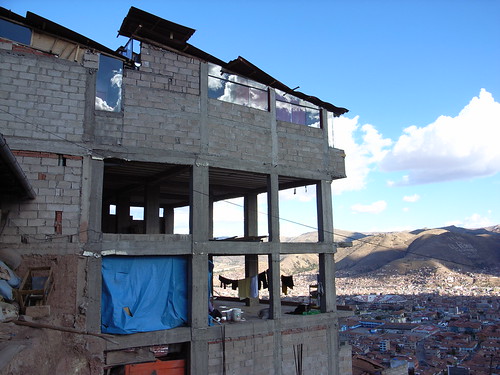 Incomplete buildings are something that fascinate me. The raw backbone of the buildings looks as if it had been never finished or strip naked after a momentarily stopped renovation. To me, the city of the near future definitely looks like this sort of architecture. And this fascination is not just poetic, it's a very recurring encounter in lots of cities due to economic and cultural issues in construction.
Incomplete buildings are something that fascinate me. The raw backbone of the buildings looks as if it had been never finished or strip naked after a momentarily stopped renovation. To me, the city of the near future definitely looks like this sort of architecture. And this fascination is not just poetic, it's a very recurring encounter in lots of cities due to economic and cultural issues in construction.
For example, the picture above has been taken in Cusco, Peru. It nicely reveals how the floors reached different levels of completeness. The one above is a restaurant where I had lunch in august, whereas the two other stories below have a totally different affordance. Sometimes, it's even more fascinating when you have incomplete skyscrapers, falling into despair. Some are totally abandoned, some only partly... with pockets of emptiness. These structures often lead to interesting new forms of socialization that would surely need some time to be uncovered.
If like me you're into this sort of things, you may be intrigued by a french architecture firm called coloco which works on this concept. Régine pointed me to their Skeleton Observatory. It's actually a summary of their exploration, about why the think this architectural typology is important and may play a role in the near future. It eventually lead them to describe projects about "inhabiting the skeletons", i.e. the re-appropriation of abandoned and incomplete architectures. The skeleton becomes and "invitation à l'usage" (i.e. "an invitation to be used"). They even have their own France-based abandoned building to test their hypotheses.
Why do I blog this? cataloguing curious signals about new forms of architecture on a pure exploratory angle.
Ethnography and design
In "Experience Models: Where Ethnography and Design Meet" presented at the EPIC2006 conference, Rachel Jones discusses the roles of ethnography in design. She gives a quick overview of the literature regarding this topic:
- "Identifying “sensitizing” concepts (the identification of researchable topics)
- Developing specific design concepts (studying settings that may shed light on what abstract design concepts might mean concretely in order to sketch out and work up potential design solutions)
- Driving innovative technological research (explore the sociality of novel design spaces opened up by radical technology in real world settings)
- Evaluating design (conduct a “sanity check” on the design. Ethnography has also been used to inform the iterative design)
- Context awareness (immersing researchers, designers and sometimes clients in the setting, for the purpose of understanding the context in which a product will be developed)
- Identifying key emerging themes (an area of study, and developed with a view to identifying design opportunities and influencing design solutions)
- Developing experience frameworks (models that identify the key components of an experience and indicate the structural relationships between those components... facilitate the generation and mapping of opportunities)"
Why do I blog this? interesting overview, material for my UX course where I show the importance of "people research" (based on ethnography-inspired methods) for design.
On a different note, I am less and less using the term ethnography because (1) I am not an ethnographer, (2) the use os methods coming from ethnography is far different from conducting ethnography, (3) there seems to be some weird trend currently that confuse ethnography with data collection.
Signage frenziness redux
What to do with light bulbs?
 An occidental kitchen, classic, with postcards, boxes and... this lighbulb. Why would people keep this? To have it up one's sleeve if another one breaks? Actually no, the bulb is sitting there because the owners do not know where to put it. In a 21st century society where you cannot trash anything (especially in Switzerland), when you don't know how to toss something, you preciously keep it.
An occidental kitchen, classic, with postcards, boxes and... this lighbulb. Why would people keep this? To have it up one's sleeve if another one breaks? Actually no, the bulb is sitting there because the owners do not know where to put it. In a 21st century society where you cannot trash anything (especially in Switzerland), when you don't know how to toss something, you preciously keep it.
Why do I blog this? thinking about practices related to electricity for my course/lecture in Paris tomorrow.
Instances of touch-based interaction
Some design issues that emerge from few instances of touch-based interactions: different sorts (touch, press, wave ...), different attitude (hold when waiting before your can touch on pic 1), use of different hands (left/right, influence of one's lateralization), the role of signs on the surface to be touched, the surface texture, presence/absence of cues indicating where to touch, multitasking with your hands (holding and touching on picture 3), etc...
About nokia open studio
The recent "Nokia Open Studio: Engaging Communities" published by Younghee Jung and Jan Chipchase is worth to read for various reasons. The obvious one is to know more about open studio/innovation and how they conducted research along this line. Their case study shows how the purpose is not to generate ideas of services but instead, to "generate inspirational and cross-referential material about the role of future technologies in participant’s lives by giving residents the opportunity to articulate their needs and aspirations, and present these in the context of their everyday life". Another reason to read it carefully is more general and concerns the underlying issues regarding UX research in a company such as Nokia (an issue I already described here). Some snippets from the document:
"The decision of what to research is decided on an approximately 6-12 month’s basis with some themes drawn from corporate strategy, guided by a consumer insights team that highlights trends of interest, and based on team member’s instinct of what will have the most impact within the corporation. The style of research could even be described as migratory in the sense that the team is drawn to where the resources - research topics of interest, and the means to carry out that research are richest. A major challenge of any kind of corporate field research is finding the right balance between field work and maintaining relevance within the corporate structure, which can involve anything from the face to face sharing of the results to hands on application of what was learned into the design process. The challenge boils down to: how to efficiently and meaningfully gather credible and interesting data, within a relatively short period of time in the field (which for us equates to about two weeks) from a research location anywhere on the planet?"
Why do I blog this some interesting material about the link between UX and design... some interesting reflections that can be useful to rethink my presentation about how field research can inform design.
The document is an interesting use case that shows the different issues related to this sort of approach.
HCI and grounded versus speculative reasoning
There's an insightful discussion going on at "interaction culture" (Jeffrey Bardzell's blog) about grounded versus speculative reasoning in HCI. It basically revolves around how HCI, though crying out for new approaches is still based on the normative notions of science, and therefore have trouble accepting other forms of knowledge productions. Namely, more speculative forms coming from philosophy (but I would also add, to some extent, more design-based discourse). What generally happens in peer-review is the following, as decribed by Bardzell:
"Part of social science’s rigor is in “grounding.” There are two acceptable ways (well, more than two but I’m focusing on two here) to ground reasoning in social sciences: one is through the careful collection, analysis, and interpretation of data. One eye opener for me as a humanist entering HCI years ago was (to me, at that time) obsessive care with which claims were made. It seemed to me then that social scientists would only make the tiniest, safest, most conservative claims; they shied away from the bold and interesting ones that really push understanding. Now I understand why that is the case: when you are making truth claims about reality, unless you have that care, there can be serious consequences as a result of speculation not only to knowledge of a state of affairs, but also action taken based on the assumption that that knowledge is true (policymaking, design, and other human interventions intended to change our world for the better). The other acceptable way to ground reasoning is by appealing to some other authority who has already done such an analysis. In this special and limited context, appeals to authority in the social sciences are, if not logically airtight, at least able to provide the epistemological foundation required for the work of the field. (...) Philosophy and more generally the humanities, in contrast, are not as strongly oriented toward truth claims about the world as it actually is. (...) So the most important question of a philosophical paper about principles in HCI is not whether the argument is grounded (an ontological concern), but rather whether the paper helps us think more productively about our field (an epistemological concern)."
To which I generally agree, based on the comments I received on paper I submitted in journal or conferences. This sort of issue was one of the reason I turned myself to design research.
Interestingly, Adam Greenfield commented on the blogpost, which is quite interesting as "Everyware" is a highly relevant piece even if, by science standards, it falls out of academic work in HCI. An excerpt from Adam's comment:
"I’m under no illusion that my work is informed by any particular intellectual rigor, let alone anything that would pass academic muster, but by the same token I obviously feel it represents some contribution to the field. Prior to publication, my expectation was very much that my book on ubicomp would be ignored by HCI-at-large, which is to say not discussed and certainly not cited. I was very pleasantly surprised that this has not been the case, which seems to me to constitute proof from existence that the field (at least as instantiated by certain institutions and powerful individuals, and at certain times and places) is able to welcome input external to almost all of its mechanisms for assessing rigor/”groundedness.”
As far as I’m concerned, that presents a felicitous picture: one of a discipline with considerable reserves of intellectual confidence and maturity."
Why do I blog this? this is an important discussion about the evolution of a field such as HCI/interaction design. Although I generally agree with Bardzell, I hope that examples such Adam's work can pave the way for the integration of more speculative work in the field.
